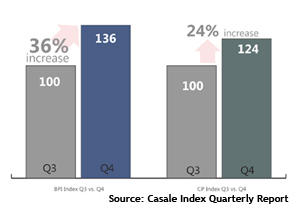This report isn't exactly coming in real-time, but Casale Media today released their Index Quarterly Report from
Q3-Q4, 2012. Casale offered RTM Daily an exclusive look at section two of the report: Market CPMs. The report takes a look at average winning bid price (WBP), number of bids per impressions (BPI), and
clear price (CP). The data comes from programmatic transactions made in the U.S. via Casale's Index platform.
In Q4 2012, the WBP was only 4% higher compared to Q3. Auto and Media
remained the leading sectors in terms of average WBP. Retail moved from number six to number four after seeing a 16% overall increase in WBP.
| Q3 2012 | Rank | Q4 2012 |
| Auto | 1 | Auto |
| Media | 2 | Media |
| Business | 3 | Travel |
| Travel | 4 | Retail |
| Education | 5 | Business |
| Retail | 6 | Entertainment |
| Entertainment | 7 | Telecom |
| Telecom | 8 | Financial |
| Health | 9 | Food & Drink |
| Financial | 10 | Health |
Source: Casale Index Quarterly Report
Education was the only sector in the top-10
in Q3 to not make the list again in Q4. The Food & Drink sector took its place. The absence on Education in Q4, as well as the inclusion of Food & Drink and the rises from Travel and Retail,
serve as further proof that seasonality impacts bidding behavior.
Although the WBP only saw a slight increase (4%), the clear price went up 24% from Q3 to Q4. Andrew Casale, VP of
strategy at Casale Media, described the clear price as the price actually paid by the buyer of the impression. "The market operates as a second price auction so the winning buyer pays the second highest bid price
plus one penny - that is the clear price," he explained.
price actually paid by the buyer of the impression. "The market operates as a second price auction so the winning buyer pays the second highest bid price
plus one penny - that is the clear price," he explained.
Essentially, even though bidders only had to bid 4% more to win in Q4, they ended up paying 24% more. The average BPI also
increased (36%) from Q3 to Q4, which the report states was brought on by the holiday shopping season. Overall, the field was more competitive.
The Index Quarterly Report findings
are reassuring for anyone with a ticket on the RTB horse. The gap between the highest and lowest bidding prices is narrowing, and the competition will continue to heat up. This will result in higher
prices, which will force more publishers to seriously consider making their inventory available on real-time marketplaces.